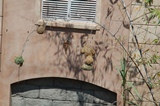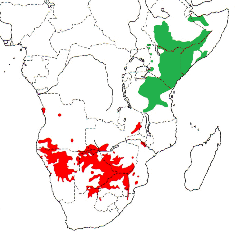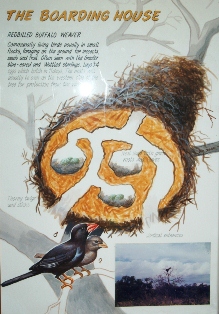Weaver species
Choose different species from drop-down list and press 'Go' button. See Full species list.Red-billed Buffalo-Weaver Bubalornis niger
IUCN: Least concern Discovery: 039Categories: black, cooperative, long tail, acacias, fruit, gum, baobab, Gymnogene, nectar, Nest use, palm, Bubalornis+Dinemellia,
News items about species
Discovery
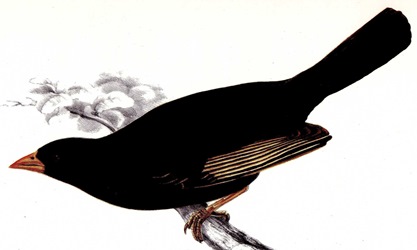
figure from Smith 1841 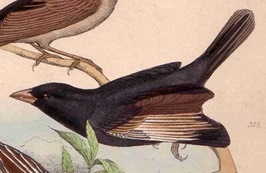
figure from Reichenbach 1863 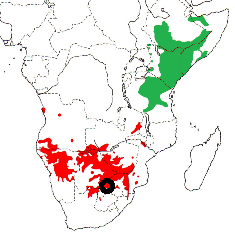
distribution, type locality circled IntroductionThe Red-billed Buffalo-Weaver was collected and formally described by Andrew Smith, a Scottish surgeon, explorer, ethnologist and zoologist. Smith organised an expedition to the interior of South Africa and he travelled to near the Botswana border in 1834-35, collecting many new birds, reptiles, mammals and other taxa along the way.Smith described the Red-billed Buffalo-Weaver from Kurrichane area. In Smith's Illustrations he expands on the locality given in the type description: 'It was not till after we had passed to the northward of the 25th degree of south latitude that we discovered this bird' (Smith 1841a). Sclater (1930) restricted the type-locality to Kurrichaine, a peak 20 km north of Zeerust. Clancey (1964) restricted it to Zeerust, a town that did not exist in Smith's day. In Smith's diary (Kirby 1940), Smith's first and only reference to the species appears on 1 August 1835. Smith left Tolane on 28 July and followed the Great Marico River to Eerstepoort, which was reached on 8 August. Smith provides daily travel times, permitting an approximate locality to be calculated for 1 August as c.25 00'S, 26 23'E (Oschadleus 2007). This buffalo-weaver was not recorded at Zeerust during the atlas (Harrison et al. 1997), but was recorded rather frequently along the Marico River. Thus the type locality is best described as Great Marico River in North West Province. The first illustration of a Red-billed Buffalo-Weaver was published by Andrew Smith in 1841 in his well known work, Illustrations of the Zoology of South Africa, being painted by George Henry Ford. The next illustration was published in Reichenbach (1863), being of a male in a similar pose to Ford's illustration. Scientific citationBubalornis niger Smith 1836; Rep. Exped. Centr. Africa, p.52; 'Country about Kurrichane'.Meaning of namesniger - Latin: niger, black, shining black (cf. ater, matt black, dead black).First English namebuffalo-bird (Livingstone 1857).Alternate namesBlack Buffalo Weaver, buffalo-bird, Coral-billed Weaver, Northern Red-billed Buffalo-Weaver, South African Buffalo Weaver, The millet eating Alectornis.CollectorAndrew Smith.Date collected1 August 1835.Locality collectedKurrichane = Great Marico River, North West Province, South Africa.Type specimensOne type specimen is known: Edinburgh NMSZ 1843.028.001, though there may be more. |
The above is based on Weaver Wednesday 2, a weekly series about the discovery of each weaver species.
This species text first appeared as
Weaver Wednesday [156] - Discovery [39]: Red-billed Buffalo-Weaver on 2015-06-10
1. Basic biology
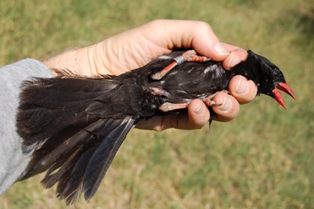
showing phalloid organ on the belly Identification. The Red-billed Buffalo-Weaver is a large, black or brownish weaver. It differs from the White-billed Buffalo-Weaver in bill colour, being red in the male Red-billed Buffalo-Weaver, orange-yellow to horn-brown in the female and immature. The male Red-billed Buffalo-Weaver is black and the female is dark brown with the underparts mottled brown and white. Immatures are similar to the female but paler brown above, with grey cheeks. Buffalo-Weavers are unique among weavers (and most birds) in that they have a solid phalloid organ on the belly in front of the cloaca. The organ is larger in males than females - the function of this organ during their prolonged copulation is not entirely certain.
Buffalo-Weavers do not normally associate with buffalo but by a twist of chance, Andrew Smith (who first described the Red-billed Buffalo-Weaver) first saw this species associating with buffalo in North West Province, South Africa. Distribution.
The Red-billed Buffalo-Weaver is found in southern and East Africa. There is a small zone of overlap in East Africa with the White-billed Buffalo-Weaver. The Red-billed Buffalo-Weaver is divided into two subspecies:
There have probably not been any major range changes for this species in historical times, but it is probably more common where it can choose man-made nest sites within its range. Habitat. The Red-billed Buffalo-Weaver inhabits savanna, dry thornveld and woodland, including dry mopane and mixed acacia-baobab woodland. It needs large trees for nesting, which may account for its patchy distribution in many areas. Food. The Red-billed Buffalo-Weaver feeds mainly on insects, particularly grasshoppers and caterpillars, but also takes seeds and fruit. The young are fed with insects only. It forages primarily on the ground where it runs or hops. It may join mixed flocks of other species to forage. Breeding. This species is usually polygynous, with one male and several females occupying a nest.
Nests are built on large trees, often baobabs. Nests are also built on man-made structures, including windmills and electricity pylons. One particularly unusual site that has not been documented in the literature is a radio mast - see photo (right). The female incubates the eggs. Nests may be infested with mites and other invertebrates. Raptors sometimes nest on top of buffalo-weaver nests and a variety of smaller birds, especially Red-headed Finches, may take over a nest chamber, eg. PHOWN 196. |
The above is based on Weaver Wednesday, a weekly series about weaver species.
This species text first appeared as
Weaver Wednesday [5]: Red-billed Buffalo-Weaver on 2012-07-18
2. Breeding facts
| Pair bond polygyny, sometimes co-operative polygynandry Breeding season mainly Mar-Jun in E Africa; Sept-Apr in S Africa; scattered records in other months; may be double-brooded Nest site 3-12m above ground in tall tree such as baobab, leadwood (Combretum imberbe), acacia, marula (Sclerocarya birrea) or mopane, even in base of nest of Yellow-billed Stork (Mycteria ibis) in Zambia; sometimes near homestead, or on man-made structure such as windmill or pylon Nest building Nest built by male, lined by both sexes with fresh green vegetation Colony size up to 13 nest-chambers Clutch size 2-4 eggs Egg colour white, heavily spotted with sepia and grey, or blue-green with olive-green and ashy markings Egg size average size 28.3 x 19.9 mm (South Africa) Incubation incubation from first egg (in captivity), by female alone, period 11-14 days Chicks and nestling period chicks fed by female, very rarely by male, nestling period 20-23 days |
Breeding information based on Handbook of the Birds of the World, Vol. 15.
3. Photos of Weaver Nests
 Vm 31111 |  Vm 31095 |  Vm 31055 |  Vm 30996 |  Vm 30544 |  Vm 30380 |
Thumb-nails of most recent PHOWN records - click on one to see its full record
See all PHOWN records for this species here.
PHOWN (Photos of Weaver Nests) provides valuable info on breeding distribution and colony sizes of weavers.
You can contribute by registering and submitting photos at Virtual Museum webpage.
4. Breeding distribution
Google map showing distribution (For species with small ranges you need to zoom in at the correct area to see the range):
yellow blob - range of weaver species; read more about this here.
![]() - PHOWN records with photos
- PHOWN records with photos
![]() - PHOWN records with no photos (Nest Record Cards, other records)
- PHOWN records with no photos (Nest Record Cards, other records)
![]() - Birdpix records
- Birdpix records
![]() - comments on out of range records, or interesting records
- comments on out of range records, or interesting records
![]() - type locality
- type locality
CLICK on the marker on the map to see individual record details.
5. Range changes
Read more in Biodiversity Observations.
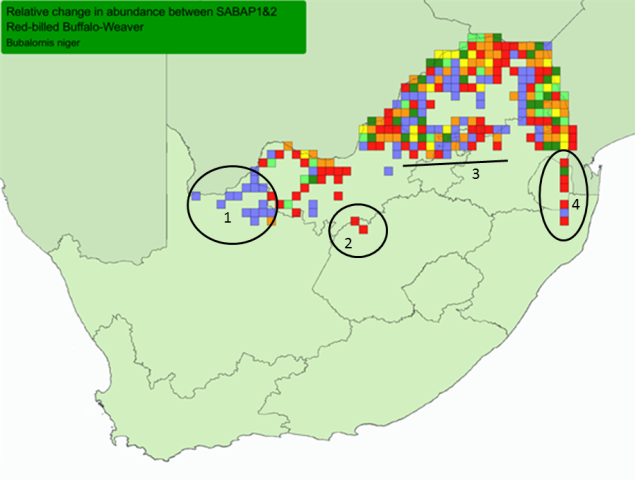
Red, orange and yellow = cells with very large, large, and small relative decreases Blue, dark green and light green = cells with very large, large and small relative increases. Cells = quarter-degree grid cells; Only cells with at least 4 checklists in both SABAP1&2 shown. All cells had this species recorded in SABAP1 or in SABAP2 or in both (more about interpretation at Biodiversity Observations 7.62: 1-13). Range changes in SA
figure from Birdpix
1. Range expansion westwards from Kathu to Askham
2. Range extinction in the Free State
3. Range stable along the 26S line of latitude
4. Range stable but low density in eastern corridor
Range changes elsewhereBotswana: expansion in SW (Tyler 2012a).Uganda: recent new records (Rossouw 1998a, Demey 2011b). Zambia: expanding north-eastwards in Kafue (Robertson 1995b). | |||||||||||||||||||||||||||||||||||
The above is based on Weaver Wednesday 3, a weekly series about range changes in South African weaver species.
This species text first appeared as
Weaver Wednesday 3 [238] - Range changes [1]: Red-billed Buffalo-Weaver on 2017-01-04








